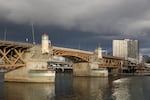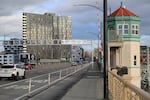
Screenshot from a November 2021 Multnomah County video show a simulation of the Burnside Bridge in Portland collapsing during an earthquake. The county has identified some cost savings refinements to the original plan to earthquake ready the bridge and request feedback from the public.
Screenshot from Multnomah County video / Multnomah County
Nathan Hoover, a historian and tour guide, stands next to the 95-year-old Burnside Bridge and looks up at the rivets and trusses that keep it standing. He’s explaining how the two concrete bascule piers that hold up the middle of the bridge are underpinned by timber — and what that might mean when a major earthquake hits.
“They’re actually 40-foot-tall tall Douglas Fir tree trunks,” he said. “There’s 380 tree trunks per bascule pier. And they’re stuck close enough together that it makes a sturdy enough foundation that you can build a bridge on top of that.
“But it’s not the sturdiest in the event of a major earthquake. It’s quite possible that it will be like a game of pick-up-sticks.”

Nathan Hoover gives bridge tours to school children and tourists at PDX Bridge Tours. He thinks the hundreds of logs that underpin the Burnside Bridge might collapse in the event of a large earthquake.
Kristian Foden-Vencil / OPB
It’s been 321 years since the last major Cascadia quake. Geologists estimate there is now a one-in-three chance of the so-called “big one” hitting the area within the lifetimes of most Oregonians.
Should a major earthquake strike, violent shaking could last up to five minutes, and Portland’s downtown bridges are not expected to remain functional.
Mike Pullen, a spokesperson for Multnomah County, said most of Portland’s bridges stand on river sediment which, in a major earthquake, will behave like wet sand being vibrated by a foot.
“When they built these bridges in the 1920s, they didn’t know we were in earthquake country. So they would go down just sort of to a level maybe 50 feet below the ground,” Pullen said. “We know now that the soils down there are highly suspect to liquification. They’re right next to the river, and in that big earthquake, there’s going to be all that sloshing around.”
Pullen said the county wants to rebuild the Burnside Bridge so it can continue operating the day after a subduction zone quake. Such a bridge would have to stand on concrete pillars dug up to 150 feet down to the geological strata known as the Troutdale Formation.

Screenshot from a November 2021 Multnomah County video showing proposed changes to earthquake ready the Burnside Bridge in Portland. The county has identified some cost savings refinements to the original plan and requested feedback from the public.
Screenshot from Multnomah County video / Multnomah County
Last year, county leaders had a plan to find the money for such a strong bridge. But then came a series of setbacks. Voters turned down a $7-billion-dollar regional transportation measure. The pandemic and inflation exacerbated the problem.
“We were looking at about an $800-million dollar project before the pandemic,” Pullen said. “Price spikes and the competition for resources has risen that to about $1 billion.”
Now the county must cut costs. The most controversial idea: Instead of widening the Burnside, the county could keep the bridge at about the same width it is now. That’d save about $150 million dollars, but the bridge would be about 17 feet narrower than hoped and would support four instead of five vehicle lanes.

Screenshot from a November 2021 Multnomah County video showing proposed changes to earthquake ready the Burnside Bridge in Portland. The county has identified some cost savings refinements to the original plan and requested feedback from the public.
Screenshot from Multnomah County video / Multnomah County
The second way to save would be to stick with a bascule design — with the road decks still pivoting toward the sky to allow passage underneath — rather than turning the Burnside into a vertical lift bridge, similar to the Hawthorne Bridge. That would save about $30 million.
County leaders briefly considered not having a drawbridge at all. But that would mean the improved Burnside would have to be much taller and longer. Pullen said a longer, taller bridge would cut into downtown: “It would have to be tall enough for the ships that maybe only come every three years, like the Rose Festival fleet. That type of bridge would be so tall, you’d get on at around Powell’s Books on the westside and around 10th Avenue on the eastside.”
The county could also save money by selling the bridge’s existing metal superstructure to someone willing to take it away, saving the cost of deconstructing and disposing of it. But there were no takers for a similar offer on the nearby Sellwood Bridge replacement project a few years ago.
Perhaps the most beloved aspect of the Burnside Bridge are the two little hexagonal lift operator houses that sit on top. Nowadays they’re not normally staffed. Ships that need to come upriver call a worker at the nearby Hawthorne Bridge, which is staffed 24/7, and then someone is sent to open the Burnside.

Multnomah County is asking the public how best to scale down the building of an earthquake-proof Burnside Bridge.
Kristian Foden-Vencil / OPB
Pullen thinks the hexagonal design could be incorporated into the new bridge. He said the skateboard park under the east side of the bridge will also remain, although it will close periodically during construction.
But all this planning could be for naught if commissioners can’t generate momentum to tear down and rebuild the bridge. They need to convince politicians in other jurisdictions — such as the state, the federal government and the city of Portland — to chip in. Before the pandemic, 40,000 Portland locals used the Burnside Bridge daily.
Multnomah County Commissioner Jessica Vega Pederson said the process of getting a bridge built is part art, part science.
“It’s a lot of personal contact. It’s reaching out. It’s talking about why this is important,” she said. “I’m going to be presenting to (the Portland) city council next week. We haven’t talked to the city commissioners since there have been three new commissioners there. So we want to make sure that they have a good understanding of what this project is.”
The Burnside was chosen for replacement because, unlike several other Portland bridges, it doesn’t run underneath another freeway or railway. So, nothing is likely to fall on it during a quake. It’s also designated as a “life-line” route by the state, meaning it must stay open for emergency services.
Meanwhile, Tuesday is the last day the public can weigh-in on the county’s money saving ideas at burnsidebridge.org.
If everything goes to plan, construction could start in 2025, and people could drive across by 2030.

Inflation has driven the cost of building an earthquake-proof Burnside Bridge up to $1 billion. Multnomah County is asking the public to weigh in on possible cost saving ideas at burnsidebridge.org
Kristian Foden-Vencil / OPB



